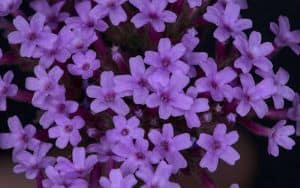Spring is here, and our dogs are excited to be getting outside a lot more. They’re going to be full of energy, sniffing everything, looking at everything, and in some cases eating everything.
Unknown piece of meat on the ground? Edible, says the dog. Dirty napkin? Edible.
We love our dogs, but seriously – do they know what they’re doing?
Sometimes.
But sometimes it’s up to us to know what’s good for them.
For example, maybe our dog has taken interest in a certain plant. Verbena is a species of plant common to both Europe and the Americas. We plant it to make our gardens look pretty and attract butterflies.
It grows wild too, sometimes near walking paths and in ditches. So, what if our dog wants to sample some verbena – or more likely, what if they already have?
Is Verbena poisonous to dogs?
First of all…
What are verbena?
If you’ve ever googled “is verbena poisonous to dogs?” the answer is not clear.
“My dog eats it all the time and she’s fine!”
“My dog eats it and pukes!”
“I heard it’s poison, but it’s not listed as a poison on such-and-such a website!”
We have a problem. Verbena, also known as vervain, isn’t just one kind of plant. Verbena are among approximately 250 different types of plant in the verbenaceae family.
Generally perennial, sometimes annual, they appear either tree-sized, shrub-sized, or spreading along the ground like a moss.
Thin-stemmed, topped with bunches of tiny five-petaled flowers coming in all different colours, verbena are often used as an ornamental plant. Some varieties are renowned for their medicinal use.
The truth is some of them are poisonous, and others aren’t.
By now you may be thinking you need a degree in botany to figure out if your dog is eating a poisonous type of verbena. Well, technically, yes. But practically, no. The message here is simply this: Learn as much as you can and then exercise caution.
Let’s learn a bit then.
Here we’ll discover:
- The most common types of verbena, and whether they’re poisonous.
- What makes verbena poisonous.
- The symptoms of potential verbena poisoning.
- What other flowers are toxic to dogs.
- How to stop your dog from eating plants it shouldn’t be eating.
Main varieties of verbena
Let’s go over the most common types of verbena so we can determine if your dog really knows what it’s doing. But please remember, this list is not at all exhaustive. Few of us are experts in identifying plants, so unless you’re 100% sure, exercise caution. And when in doubt, stop googling and call your vet!
- Lemon verbena:
Sometimes known as lemon beebrush, this verbena is a perennial shrub growing up to 3 metres (10 feet high), with tiny white flowers popping out amongst purplish buds. Lemon verbena is popular because it smells amazing. The leaves are long, glossy, and give off a lemon smell when bruised. It is sometimes cultivated for its oil, used as seasoning, food, and even as an alternative medicine.
While websites consider lemon verbena only “mildly toxic,” or “generally safe” in small amounts, the American Society for the Prevention of Cruelty to Animals (ASPCA) has included it on its list of plants toxic to dogs. So while we’re erring on the side of caution…
Verdict: TOXIC
- Lantana
New word of the day. Aposematism: the way an animal – often a frog, butterfly, caterpillar, or snake – advertises its poisonousness by being brightly coloured.
Similarly, lantana, or lantana camara, is poisonous. It says so by colouring itself in vivid oranges, pinks, purples, reds, yellows, and whites, sometimes all at once. Often, clusters of lantana, and even the flower bunches themselves are multicoloured, even changing colour as the blooming season progresses.
If it’s coloured like the rainbow, you know the deal. And the ASPCA agrees…
VERDICT: TOXIC
- Purpletop Verbena
Called verbena bonariensis by aficionados, this verbena is a perennial growing up to 2 metres (6 feet) high. Known for being so darn pretty, purpletop catches the eye with its thin, rough, square-ish, sparsely leaved stems, and rosy lavender flower clusters.
Some people online report that their dogs love to eat it. Others say their dogs are indifferent. And despite some claims online about dogs throwing up after eating verbena bonariensis, it is not listed by the ASPCSA, or anywhere else for that matter as toxic. Make sure you’re dealing with purpletop, otherwise…
Verdict: SAFE
- Trailing Verbena
Also known as glandularia canadensis, popular types of trailing verbena include homestead purple, appleblossom, summer blaze, snowflurry, greystone daphne… The list goes on. These are low-spreading plants, growing up to 30 cm (1 foot) high, but covering up to 1.5 metres (5 feet) of ground. People love to use them as bedding plants because they take up space whilst looking wonderful. Homestead purple, perhaps the most popular trailing verbena, is an annual, featuring deep green leaves and rich violet flowers protruding from a distinctive spiky purple-green bud.
Nowhere is trailing verbena listed as toxic to dogs. As always, just make sure you’re actually dealing with glandularia canadensis.
VERDICT: SAFE
- Moss verbena
This sprawling, low-growing perennial has fern-like leaves and purple flowers. Also known as verbena tenuisecta, this hardy species originated in South America and is now found all over the southern United States. You’ll see it in all the places your dog loves to sniff. Fortunately, however, it is not listed as toxic.
VERDICT: SAFE
Why are some verbena poisonous to dogs?
The truth is there is a lot we don’t know about why some of these verbena are poisonous to dogs. In the case of lemon verbena, there is some indication the essential oil has neurotoxic properties. In small doses it may act as a sedative, an anticonvulsive, and calm an upset stomach. In higher doses it’s dangerous.
In the case of Lantana, signs point to something called pentacyclic triterpenoids and pentacyclic triterpene acids, which in high doses can harm the liver, kidneys, gall bladder, and bile system.
Different parts of these plants, ie: the flowers and berries, may be more poisonous than other parts.
What are the symptoms of verbena poisoning?
- Vocalizing
- Bloating
- Diarrhea
- Weakness
- Loss of appetite
- Diarrhea, including bloody diarrhea
- Vomiting
- Laboured breathing
- Depression
- Light sensitivity
- Frequent urination
- Dark yellow urine
- Yellowing of the eyes and skin
- Paralysis
Lemon verbena poisoning symptoms may be milder, and include only upset stomach, bloating, diarrhea, vocalizing, loss of appetite, and vomiting.
In the case of lantana poisoning, weakness and appetite loss may appear in the first 24 hours, but more serious symptoms may develop over the course of days. Severity depends on many factors, including your dog’s tolerance, how much your dog ate, which part of the plant it ate, and the specific type of lantana.
If you are sure your dog ate either lemon verbena or lantana, don’t wait! Call your vet and get expert advice right away.
What other flowers are toxic to dogs?
Keeping the focus on flowers you might have in your garden, here are twenty others that are known to be toxic to your dog:
- Begonia
- Oleander
- Milkweed
- Baby’s breath
- Daffodil
- Azalea/rhododendron
- Amaryllis
- Chrysanthemum
- Tulip
- Gladiola
- Hyacinth
- Peace Lily
- Crocus
- Tiger Lily
- Morning Glory
- Narcissus
- Fox glove
- Geranium
- Yarrow
- Primrose
How to stop your dog from eating verbena
You could apply this to any poisonous plant, really. And there isn’t just one way to do it. Few dogs are alike.
The basics, as always, apply. Ensure your dog is well-exercised and mentally stimulated. They get into more trouble when they’re bored. Also, a dog whose energy is drained is easier to train.
Some dogs will obey if you simply say, “don’t touch!” or, “no!” Other dogs respond to training techniques that involve repetition and rewards. Establish boundaries, the same way you do in the house. The techniques that prevent your dog from begging for food at the table or climbing onto the furniture will work here. You know your dog best!
In other cases you may have to set up a barrier between them and the verbena. A garden fence or chicken wire might work, or you could plant your verbena in the middle of other plants where your dog will not want to step.
Apparently, some dogs are deterred by powdered red pepper or powdered mustard sprinkled around plants, but I’ve watched a dog sneeze its way through snacking on garden vegetables. Worth a try at least. Lemon spray and vinegar spray are also known to work.
Most importantly, just be in charge. It’s for your dog’s safety after all.
Conclusion
It can be frustrating to look for a single answer to a problem, ie: is verbena poisonous to dogs, only to discover it’s not so straightforward. Yes and no. But it’s worth it, right? No need to bulldoze your garden if it’s full of safe varieties of verbena.
Let’s give our dogs some credit. Generally, they do know what they’re doing. Until they start looking at lantana the way we look at gummy bears.
Give yourself some credit too, for knowing the right questions to ask, and knowing where to look for answers. But let’s face it, we aren’t botanists, we aren’t veterinarians, and we make mistakes. It was only a few years ago people were eating Tide pods.
When in doubt, stop Googling and call the vet.






